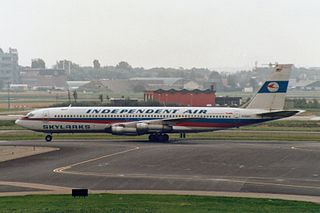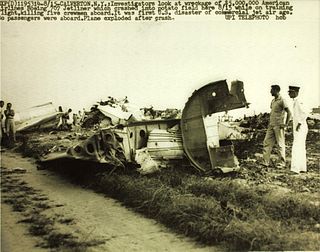
Leonardo da Vinci Rome Fiumicino Airport is an international airport in Fiumicino, Italy, serving Rome. It is the busiest airport in the country, the 9th-busiest airport in Europe and the world's 46th-busiest airport with over 40.5 million passengers served in 2023. It covers an area of 16 square kilometres (6.2 sq mi).
This is a list of aviation-related events from 1979.

G. B. Pastine–Rome Ciampino Airport is the secondary international airport serving Rome, the capital of Italy, after Leonardo da Vinci–Rome Fiumicino Airport. It is a joint civilian, commercial and military airport situated 6.5 NM south southeast of central Rome, just outside the Greater Ring Road the circular motorway around the city.

Addis Ababa Bole International Airport is an international airport in Addis Ababa, Ethiopia. It is in the Bole district, 6 km (3.7 mi) southeast of the city centre and 65 km (40 mi) north of Bishoftu. The airport was formerly known as Haile Selassie I International Airport. It is the main hub of Ethiopian Airlines, the national airline that serves destinations in Ethiopia and throughout the African continent, as well as connections to Asia, Europe, North America and South America. The airport is also the base of the Ethiopian Aviation Academy. As of June 2018, nearly 380 flights per day were using the airport.

Uganda Airlines, legally Uganda Airlines Corporation, was the flag carrier of Uganda. The airline was established in May 1976, and started operations in 1977. It was headquartered in Entebbe, Wakiso District, Uganda, and operated from its hub in Entebbe International Airport.
The article describes accidents and incidents on Korean Air and its predecessor companies Korean National Airlines and Korean Air Lines.

On 8 February 1989, Independent Air Flight 1851, a Boeing 707 on an American charter flight from Bergamo, Italy, to Punta Cana, Dominican Republic, struck Pico Alto while on approach to Santa Maria Airport in the Azores for a scheduled stopover. The aircraft was destroyed, with the loss of all 144 people on board, resulting in the deadliest plane crash in Portugal's history. All of the passengers on board were Italian and all of the crew were Americans. The crash is also known as "The disaster of the Azores".

Air India Flight 403 was a scheduled Air India passenger flight that crashed at Sahar International Airport in Bombay, India on 21 June 1982. It was likely caused by miscalculated altitude in a heavy rainstorm. The aircraft was the first jetliner inducted into the fleet of an Asian airline.

EgyptAir Flight 864 was a flight from Rome Fiumicino Airport to Tokyo International Airport, via Cairo, Bombay, and Bangkok. On 25 December 1976, the Boeing 707 crashed into an industrial complex in Bangkok. All 52 people on board were killed, plus 19 on the ground in the crash.
Air France has been in operation since 1933. Its aircraft have been involved in a number of major accidents and incidents. The deadliest accident of the airline occurred on June 1, 2009, when Air France Flight 447, an Airbus A330-203, flying from Rio de Janeiro to Paris crashed into the Atlantic Ocean with 228 fatalities. A selected list of the most noteworthy of these events is given below.

American Airlines Flight 514 was a training flight from Idlewild International Airport, to the Grumman Aircraft Corp. airfield. On the afternoon of August 15, 1959, the Boeing 707 operating the flight crashed near the Calverton airport, killing all five crew members aboard. This was the first accident to involve a Boeing 707, which had only gone into service in October of the previous year, and the first of three accidents involving American's 707s in the New York area within three years, followed by Flight 1502 and Flight 1.

Varig Flight 810 was a scheduled international passenger flight from Rio de Janeiro to Los Angeles with stopovers in Lima, Bogotá, Panama City, and Mexico City. On 27 November 1962, the Boeing 707-441 operating the route crashed into a mountain on approach to Lima, killing all 97 passengers and crew. At the time it was the deadliest aviation accident in Peru until being surpassed by LANSA Flight 502 in 1971 and later Faucett Perú Flight 251 in 1996.

On 14 January 2019, a Boeing 707 operated by Saha Airlines on a cargo flight crashed at Fath Air Base, near Karaj, Alborz province in Iran. Fifteen of the sixteen people on board were killed. This aircraft was the last civil Boeing 707 in operation.










